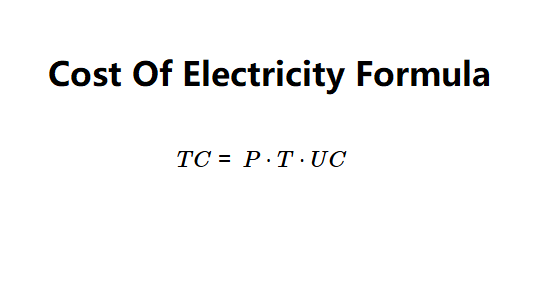 Home
Home
 Back
Back

Definition: This calculator computes the total cost of electricity (\( TC \)) for an appliance based on its power consumption (\( P \)), the duration of use (\( T \)), and the unit cost of electricity (\( UC \)).
Purpose: It is used to estimate the cost of operating electrical appliances, helping users manage energy expenses and make informed decisions about energy usage.
Total cost is calculated using:
Power conversions:
Explanation: The input power (\( P \)) is converted to watts, and the duration (\( T \)) is converted to hours. The unit cost (\( UC \)) is either selected from a state’s electricity rate or manually entered in USD/kWh. The power is converted to kilowatts (kW) for the cost calculation, and the total cost is computed in USD, then converted to cents for display. Small cost values are shown in scientific notation for clarity.
Details: Calculating the cost of electricity helps users understand the financial impact of operating appliances, encouraging energy efficiency and cost-saving measures. It’s also useful for budgeting and comparing electricity rates across different regions.
Tips: Enter the appliance power (\( P \)) in W, kW, or MW, and the consumption duration (\( T \)) in h, min, or s (both must be greater than or equal to 0). Select a state to use its electricity rate, or choose "Custom Cost" to enter a unit cost in USD/kWh (must be greater than or equal to 0). The result will be the total cost in USD and cents. Costs less than 0.00001 will be displayed in scientific notation.
Examples:
Q: What is the unit cost of electricity?
A: The unit cost of electricity (\( UC \)) is the price per kilowatt-hour (kWh) of electricity, typically in USD/kWh. It varies by region; for example, the U.S. average is 0.124 USD/kWh, while Hawaii has a high rate of 0.332 USD/kWh.
Q: Why can’t power, duration, or unit cost be negative?
A: Power, duration, and unit cost represent physical quantities (energy consumption, time, and cost per unit of energy). Negative values are not meaningful in this context, as they would imply negative energy use, time, or cost.
Q: How do I find the power consumption of my appliance?
A: The power consumption (\( P \)) is usually listed on the appliance’s label or in its manual, often in watts (W). For example, a 60 W light bulb consumes 60 watts of power.
Q: Why are small cost values displayed in scientific notation?
A: Costs less than 0.00001 (e.g., \( 1 \times 10^{-5} \)) are displayed in scientific notation for clarity, as they are very small and would otherwise show as long strings of zeros in decimal format (e.g., 0.000000416667 USD becomes \( 4.166667e-07 \, \text{USD} \)).
Q: Why is the cost displayed in both USD and cents?
A: Displaying the cost in both USD and cents provides flexibility. Small costs (e.g., for short durations or low-power appliances) are more readable in cents, while larger costs (e.g., for high-power appliances over long periods) are better in USD.